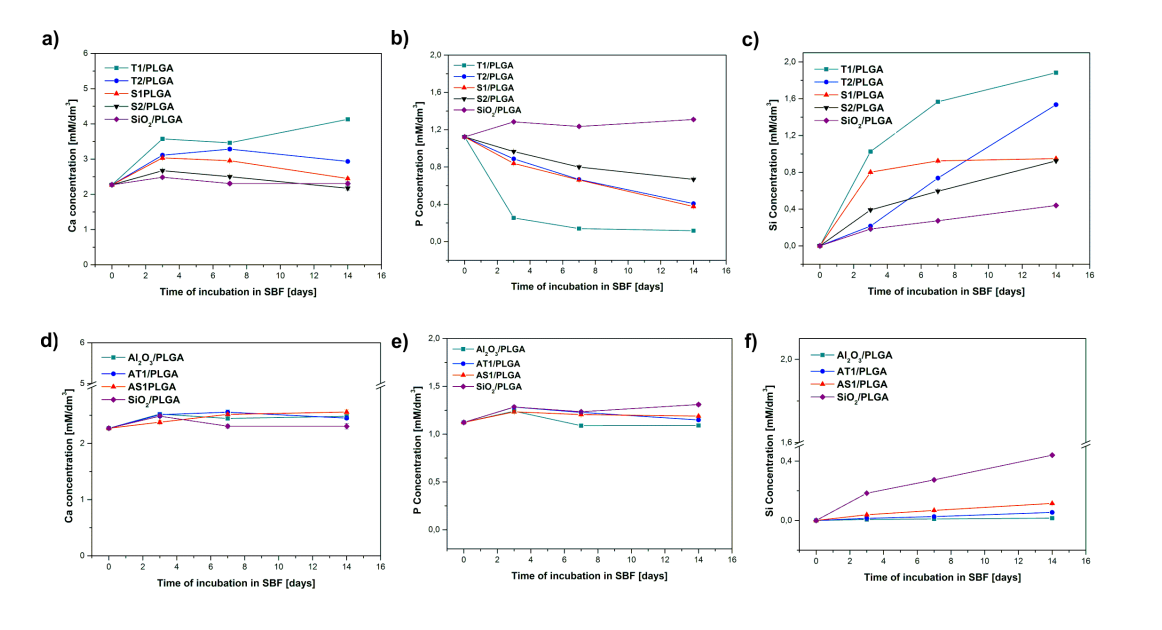Bioactivity of PLGA-gel-derived bioglass composites
DOI:
https://doi.org/10.5604/01.3001.0012.8153Keywords:
polymer-ceramic composites, bioactive propertiesAbstract
A series of PLGA (poly L-lactide-co-glycolide) based composites modified with gel-derived glasses in the form of foils were obtained by solvent casting procedure. As a modifier, glass particles with different chemical compositions from the CaO–SiO2, CaO–P2O5–SiO2, and Al2O3–SiO2 systems were used. All glasses were synthesized by the sol-gel process. Evaluation of bioactive properties of obtained composites was made on the basis of surface changes occurring during contact with simulated body fluid. The changes of Ca, P and Si ions concentration in SBF after incubation of composites were also measured. The result showed that all composites with bioglasses (CaO–SiO2, CaO–P2O5–SiO2) exhibit formation of calcium phosphates layer after SBF test, however, kinetics of Ca, Si ion release and P uptake from SBF was dependent on bioglass chemical composition. The higher solubility, as well as faster consumption of phosphorus from SBF, was observed for materials from CaO–SiO2 (T1/PLGA, S1/PLGA) compared to composites with respective bioglass particles from the CaO–P2O5–SiO2 (T2/PLGA, S2/PLGA). Our results showed that rate of Si and Ca release from the gel-derived glasses and P uptake from SBF are dependent on both: the concentration of respective ions in the materials and the presence of phosphates in their structure. For materials modified with gel-derived glasses from Al2O3–SiO2 system no significant surface changes during contact with SBF were observed, and it seems that their behavior in physiological solution indicate that they are bio-inert materials.
Downloads
References
Dziadek M, Pawlik J, Cholewa-Kowalska K, Szkła bioaktywne w inżynierii tkankowej, Acta Bio-Opt. Inform. Med., 2014; 20(3):156–165. Google Scholar
Pamula E, Kokoszka J, Cholewa-Kowalska K, Laczka M, Kantor L, Niedzwiedzki L, Reilly GC, Filipowska J, Madej W, Kolodziejczyk M, Tylko G, Osyczka AM, Degradation, bioactivity and osteogenic potential of composites made of PLGA and two different sol-gel bioactive Glassem, Ann. Biomed. Eng, 2011; 39(8):2114–2129. Google Scholar
Dziadek M, Zagrajczuk B, Menaszek E, Wegrzynowicz A, Pawlik J, Cholewa-Kowalska K, Gel-derived SiO2–CaO–P2O5 bioactive glasses and glass-ceramics modified by SrO addition, Ceram. Int., 2016; 42(5):5842–5857. Google Scholar
O’Brien FJ, Biomaterials & scaffolds for tissue engineering, Mater. Today, 2011; 14(3):88–95. Google Scholar
Hoppe A, Güldal NS, Boccaccini AR, A review of the biological response to ionic dissolution products from bioactive glasses and glass-ceramics, Biomaterials, 2011; 32(11):2757–2774. Google Scholar
Rahaman MN, Day DE, Bal BS, Fu Q, Jung SB, Bonewald LF, Tomisa AP, Bioactive glass in tissue engineering, Acta Biomater., 2011; 7(6):2355–2373. Google Scholar
Dobrzański P, Kasperczyk J, Janeczek H, Bero M, Synthesis of Biodegradable Copolymers with the Use of Low Toxic Zirconium Compounds. 1. Copolymerization of Glycolide with l-Lactide Initiated by Zr(Acac)4, Macromolecules, 2001; 34(15):5090–5098. Google Scholar
Zagrajczuk B, Dziadek M, Olejniczak Z, Cholewa-Kowalska K, Laczka M, Structural and chemical investigation of the gel-derived bioactive materials from the SiO2–CaO and SiO2–CaO–P2O5 systems, Ceram. Int.,2017; 43(15), 12742–12754. Google Scholar
Ohtsuki C, Kushitani H, Kokubo T, Kotani S, Yamamuro T, Apatite formation on the surface of Ceravital-type glass-ceramic in the body, J. Biomed. Mater. Res., 1991; 25:1363–1370. Google Scholar
Letaief N, Lucas-Girot A, Oudadesse H, Meleard P, Pott T, Jelassi J, Dorbez-Sridi R, Effect of aging temperature on the structure, pore morphology and bioactivity of new sol–gel synthesized bioglass, J. Non-Cryst. Solids, 2014; 402:194–199. Google Scholar
Saravanapavan P, Jones JR, Pryce RS, Hench LL, J. Biomed. Mater. Res., Bioactivity of gel-glass powders in the CaO–SiO2 system: a comparison with ternary (CaO–P2O5–SiO2) and quaternary glasses (SiO2–CaO–P2O5–Na2O), 2003; 66(1):110–119. Google Scholar
Vallet-Regi M, Izquierdo-Barba I, Salinas AJ, Influence of P2O5 on crystallinity of apatite formed in vitro on surface of bioactive glasses, J. Biomed. Mater. Res,.1999; 46(4):560–565. Google Scholar
Vallet-Regi M, Romero AM, Ragel CV, LeGeros RZ, J. Biomed. Mater. Res.,1999; 44(4):416–421. Google Scholar
Taddei P, Tinti A, Reggiani M, Fegnano C, J. Mol. Struct, 2005; 744:135–143. Google Scholar
Lucas-Goriot A, Mezahi FZ, Mami M, Oudadesse H, Harabi A, Le Floch M, Sol-gel synthesis of a new composition of bioactive glass in the quaternary system SiO2–CaO–Na2O–P2O5, J. Non-Cryst. Solids, 2011; 357(18):3322–3327. Google Scholar
Jagan Mohnini G, Krishnamacharyulu N, Sahaya Baskaran G, Venkateswara Rao P, Veeraiah N, Studies on influence of aluminium ions on the bioactivity of B2O3–SiO2–P2O5–Na2O–CaO glass system by means of spectroscopic studies, Appl. Surf. Sci., 2013; 287:46–53. Google Scholar
Gerhardt L-C, Boccaccini AR, Bioactive Glass and Glass--Ceramic Scaffolds for Bone Tissue Engineering, Materials (Basel), 2019; 3(7):3867–3910. Google Scholar
Sun JY, Yang YS, Zhong J, Greenspan DC, The effect of the ionic products of Bioglass® dissolution on human osteoblasts growth cycle in vitro, J. Tissue Eng. Reg. M., 2007; 1(4):281–286. Google Scholar
Mami M, Lucas-Girot A, Oudadesse H, Dorbez-Sridi R, Mezahi FZ, Dietrich E, Investigation of the surface reactivity of a sol–gel derived-glass in the ternary system SiO2–CaO–P2O5, Appl. Surf. Sci., 2008; 254(22):7386–7393. Google Scholar
Rámila A, Vallet-Regi M, Static and dynamic in vitro study of a sol-gel glass bioactivity, Biomaterials, 2001; 22(16):2301–2306. Google Scholar

Downloads
Published
How to Cite
Issue
Section
License
Copyright (c) 2018 University of Applied Sciences in Tarnow, Poland & Authors

This work is licensed under a Creative Commons Attribution-NonCommercial 4.0 International License.



